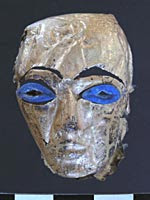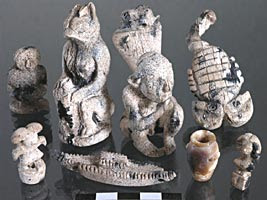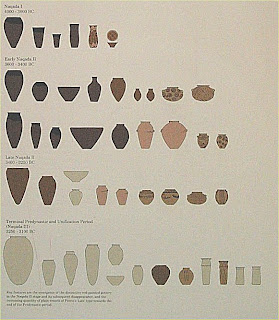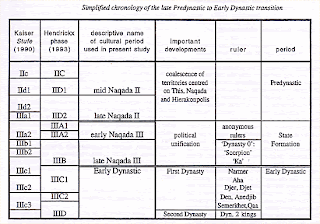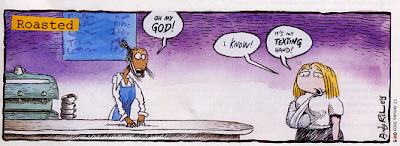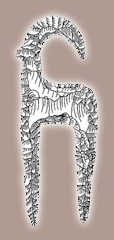 For those of you who have absolutely no interest in the Predynastic or Early Dynastic all I can do is apologise for the fact that this has been a very tedious two weeks for you. I'm back to real life on Monday, but to be honest with you there has been precious little news to convey. I've been keeping a weather eye on it and there has been nothing terrible interesting around - which is quite usual in the summer months when no-one is actually working in the field.
For those of you who have absolutely no interest in the Predynastic or Early Dynastic all I can do is apologise for the fact that this has been a very tedious two weeks for you. I'm back to real life on Monday, but to be honest with you there has been precious little news to convey. I've been keeping a weather eye on it and there has been nothing terrible interesting around - which is quite usual in the summer months when no-one is actually working in the field.I would just like to convey sincere thanks to Jan Picton of the Petrie Museum of Egyptian Archaeology for letting me loose on the colloquium whenever things are quiet at the Bloomsbury Summer School. I missed final registration at the colloquium and was told that it was sold out but thanks to the truly kind assistance of Jo Rowland, I was told that I could attend after all. But by then I had already committed to Bloomsbury. So I have only been able to dash in and out, but I have really enjoyed the papers that I have been able to attend. I thought that some of you might enjoy them too!
The proper title for the colloquium is actually Egypt at its Origins - The Third International Colloquium on Predynastic and Early Dynastic Egypt. Unsurprisingly, it is referred to as Origins 3. I was at Origins 2 in Toulouse, and publication of the Proceedings from that conference is now available if anyone is interested.
I am still typing up my lecture notes. I always feel like such a poser when I take my laptop along with me but I really should just grit my teeth and do it because I type much faster than I write and I wouldn't now be sitting here trying to decipher my ghastly scrawl. These are not the best notes that ever emerged from a lecture theatre, for which my apologies, and some are rather worse than others, but I hope that they give the gist of some of the work that is being carried out at the moment.
These are my notes from the afternoon of Tuesday 29th July 2008.
David Anderson
Evidence for early ritual activity in the Predynastic settlement at el-Mahasna
David Anderson was not present so his lecture was presented by a colleague whose name I sadly failed to catch.
The site of El Mahasna is located 11km north of the core area of Abydos. The entire area has been encroached upon since the1980s by an extension of cultivated land in the area, and this now reaches right up to the site., which covers an area of some 8 hectares.
The site was first excavated by Garstang in 1900-1901 and the Predynastic cemetery was examined by Ayrton and Loat some years later.
There are two distinct zones of activity at the site: the settlement at the borders of the alluvial plain and the low desert and the cemetery.
The el-Mahasna Archaeological Project began work in 2000. During the first two month season the team did a surface collection of the area believed to be the Predynastic settlement area using a system of controlled collection units. Pottery sherds were particularly dense in one particular area. The distribution was used as a guide for planning the excavation, which took place in a number of areas.
The excavation revealed Predynastic settlement remains from Naqada Ic-Icd.
Amongst the findings from the excavation was evidence for a building made of wooden and reed posts lashed together with cord and matting, of which remnants were found. A similar method of construction has been found at Adaima. The building was divided internally. An external activity area included a hearth and a midden which contained lithic debit age as well as animal and plant remains.
A different area of the site was occupied in Naqada Ic to 2c, where a number of in tact Predynastic layers were found. A building referred to as “Block 3” was marked by substantial reinforced post holes. Considerably more labour would have been invested in this building than in the one described previously, but conclusions are not yet possible as to its function because it has not yet been completely excavated. On the overlying floor there were use remains, which included ceramic vessels, bone awls and needles, spindle whorls, bifacial knives and grinding stones. They have been placed in the period 1c-IIab. A collection of figurines were also found which seem to have had a ritual function. Twenty one zoomorphic figurines were found in Block 3, all heavily stylized and minimalist bovines. Features were only hinted at. There were also five anthropomorphic figurines which appear to have been discarded following use within the structure. This is a very specialized assemblage which appears to have had a specific function associated with Block 3. A faunal assemblage from the same structure includes a number of bovid foreleg limbs, a characteristic feature of offering scenes from Pharaonic times. There was also a concentration of wild game, including fish - some of which were vast. (a similar situation occurred at Hierakonpolis). The combination of wild fauna indicate that they were collected in the period immediately prior to the annual inundation. A considerable amount of effort would have been required to transport some of the catfish and Nile Perch (up to a metre long and very heavy) from the Nile to the site, which is some distance away from the river. There was also a concentration of C and D ware at this part of the site
It was suggested that the evidence from Block 3 suggests an ideology based on women and cattle, and that ritual activity may have taken place at the time of the annual Nile floods. Block 3 was therefore probably a cultic centre belonging to the Naqada Ic-IIab period.
The areas of usage, both settlement and cemetery, appear to have been avoided by occupants of the area in the Old Kingdom and First Intermediate Periods, perhaps due to an ongoing sense of respect for the sanctity of those areas.
Veerle Linseele and Wim Van Neer
Animal bones from ritual contexts at Hierakonpolis
Hierakonpolis is the largest known site from the Predynastic period in Egypt. Faunal remains from four seasons of excavation, together with material derived from previous seasons, have provided a large zoological dataset. The analysis of the data from two areas of the site was the focus of the lecture:
HK29A one of the earliest known temples in Egypt, dating to the Predynastic (second temple has also been found at Hierakonpolis)
HK6, the elite cemetery site which has produced some interesting finds, including tombs with superstructures, wild and domesticated animal burials, and the well known masks. It had two phases of use: Naqada IC-IIB and Naqada IIIA2
Both areas produced faunal assemblages which were unusual. The lecture compared the two areas with each other, and with other contemporary sites in Egypt.
Comparisons with Adaima and El Mahansa were being carried out, although the full data from the latter site has not yet been published in full.
The faunal assemblage from HK29A included:
- Nile Perch (1-2m in length)
- Softshell turtle
- Crocodile
- Wild game
- Hunted species
- Carnivores, especially dogs
- Cattle (which, unlike other sites in Egypt, are more numerous than sheep and goat), slaughtered young
All these animals were available locally and, judging by the species, it seems likely that they were killed shortly prior to the annual inundation. For example, Nile perch is a deep water fish which is much easier to catch at low water, and game is much easier to capture at that time of year because animals tend to gather around the water at the end of the dry season.
Linseele suggests that they may have been linked to elite social status, and that this is indicated by a demonstration of consumption of even dangerous animals. It may also represent a desire to establish order over chaos.
The faunal assemblage form HK6 included animals supplied as food and animal burials. The use of wild animals in the first phase of usage at HK6 is unique in Egypt:
Sea shells, sea urchins
Wild mammals
- Oryx
- Elephant
- Wild donkey
- Baboon
- Swamp cat
- Hippos
Domesticated mammals
- Sheep
- Goat
- Cattle
- Dogs (9 in one grave)
- Cats (7 in one grave, next to the dog burial)
- No pigs
The wild animals are all species which, unlike those from HK29A are difficult to obtain., and the species chosen are not the same as those from HK29A. Lineseele says that the bone pathologies of the animals indicate that they had been held in captivity prior to their deaths.
Her comparison of the two areas with each other suggested that the animals represented had been involved in rituals, and that their presence and treatment were consistent with ritual behaviour,. However, the different types of animals involved in each area implies that the different types of ritual required different types of animal, each specie being associated with different concepts. The fact that some species in the elite cemetery were difficult to obtain may be a demonstration of status or identity by the person responsible for their capture, or they may have had a symbolic association. Linseele pointed out that their presence in graves may not be a sign of ritual slaughter but might instead be an indication that their owners did not have the skills to maintain wild animals in captivity.
Linseele made various observations about the differential quantities of each specie at various sites, comparing them with numbers at Hierakonpolis, but the slides, showing detailed tables of data, moved too quickly for me to note down any useful information on the subject.
Gwenola Graff and Stan Hendrickx
Architectural representations on D-Ware
It was extremely hot during this lecture and my note-taking lapsed in the middle when I left my notes in order to dig out some water, and I can’t for the life of me remember what I missed, so my apologies that my notes fail to do full justice to the lecture.
During the completion of research into the complete known corpus of D-Ware from Egypt Graff was able to list all motifs shown on this type of pottery. Some of the motifs are easy to identify but others are more ambiguous. In the latter category is a particular motif which consists of two rectangles with hache-type fill, connected by lines at the top and bottom and sometimes elaborated with small fringe-like lines, and sometimes arched. Although this lecture focused on D-Ware Graff says that the motif is also found on C-Ware.
It is believed that this motif may represent mat-like fencing which was supported on poles, which is a standard building fabric throughout the early Predynastic - even when more monumental building projects began to take place.
Graff listed a number of examples where similar motifs occur (e.g. Ballas Q593, Ballas Q81, Ashmolean 1958-345, QS76), although she and Hendrickx were first particularly drawn to an example from an unprovenanced vessel in the collection at Tubingen (Tubingen N176, published in 1984). There are 46 vases which show this image.
In the lecture Graff investigated the possible links between the motifs on the ceramics and examples known from archaeological sites.
Graff also examined the contexts within which the patterns on D-Ware. She believes that they are cultic buildings because of their association with other ritual motifs (which she defines on the basis of a set of specific criteria). She that they appear on two thirds of all cases where they are present with ibex, bird and addax images. On the Tubingen example the addax is a dominant motif. Her view is that the addax has an explicitly ritual association, and that this can be extended to embrace the architectural motifs with which they so frequently appear. She
suggested that the buildings may be directly associated with space that was used to enclose these species. A C-Ware example (Turino S1827) shows a white cross-lined scene with similar structures associated with trapped animals.
From there she looked at contexts where huts are involved in ritual contexts from other datasets - for example Naqada III labels, and the Hierakonpolis temple.
Graff says that there are opposing views on whether or not the mat-built buildings were prototypes for the niched architectural form. She suggests that the nature of the architecture was reproduced in stone at Saqqara, where the façade of the temple has similarities with the mat type appearance. However, she says that although Hendrickx supports the idea that the buildings were fore-runners of niched architecture, Alejandro Serrano-Jimenez disagrees.
Graff then went on to compare her suggestions with the data from Hierakonpolis, to see whether there was evidence for death of the aforementioned animals in the temple data. As far as birds are concerned there were no ostriches at the Hierakonpolis temple site but there was ostrich eggshell at the elite cemetery HK6.
Graff and Hendrickx hope that this identification of this type of structure with explicitly ritual contexts will help field archaeologists to identify and understand them when they occur in excavations.
And Finally - a brief and spontaneous update re the Hierakonpolis Temple HK29A
At the end of Gwenola Graff's lecture Renee Friedman stood up and said that the reconstructions shown of the Hierakonpolis temple shown in the presentation were now potentially inaccurate because of work completely in the previous season. Excavation of the main building revealed a set of post holes behind the current set, but the evidence for the building only extends around 9m from the first set of post holes - the rest has been destroyed by sebakh digging, which means that it is impossible to know whether or not the temple structure extended any further backwards than 9m.


